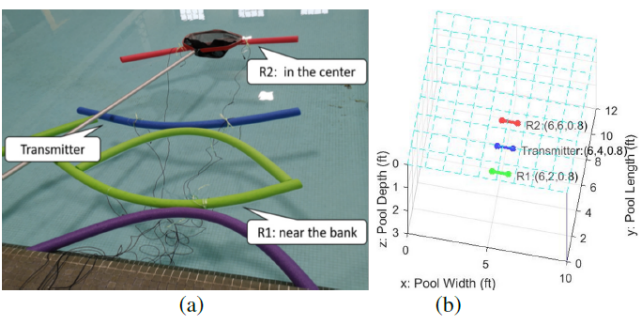Underwater Adaptive Video Transmissions using MIMO-based Software-Defined Acoustic Modems
Research | | Links:

Achieving reliable acoustic wireless video transmissions in the extreme and uncertain underwater environment is a challenge due to the limited bandwidth and the error-prone nature of the channel. To adapt to the underwater channel with variable video qualities and also leverage the benefits of using a software-defined modem, we propose an adaptive cross-layer solution for underwater video transmissions using a Multi-Input Multi-Output (MIMO)-based reconfigurable Software-Defined Acoustic Modem (SDAM) given the latest Universal Software Radio Peripheral (USRP) family product designed by the National Instrument (NI). For the application layer, we apply videos with different types of Scalable Video Coding (SVC) scalability, which show different error robustness with varying levels of environment Signal-to-Noise Ratio (SNR). For the physical layer, given the underwater channel-compatible scalable coded video with a user-defined tolerable level of distortion, we navigate the multiplexing-diversity tradeoff with the MIMO structure to balance transmission data rate and reliability. Experiment results show that “multiplexing” improves the transmission data rate significantly at high SNRs, while “spatial diversity” enhances the video quality at low SNRs. We also add an error-control layer, where the Unequal Error Protection (UEP) is applied to improve the system robustness by encoding the video header packets with low channel coding rates and encoding the video body packets with high channel coding rates, since the video header packets is more important than the video body packets. Our proposed UEP seldom reduces the Physical-Layer Throughput (PLT) (which influences the achievable video streaming bitrate) and achieves higher reliability so as to avoid error propagating from important parts to less important parts. Different from terrestrial channels, the underwater channels are time-varying and the variation is hard to estimate. Therefore, we do not fix the MIMO schemes or the combination of channel coding rates but select the appropriate scheme according to the time-varying channel and users’ requirements. With this cross-layer solution, the channel capacity is improved by joint work of MIMO and UEP within the limited underwater acoustic channel, the video reaches the optimal PLT within the channel capacity and video scalability, and video distortion is reduced. While optimizing the video quality, results shows that the optimal Quality of Service (QoS) cannot stand for Quality of Experience (QoE) completely, so we take both the objective and subjective metrics into our decision process in the algorithm to make the optimization results closer to the human experience. All these are well-designed in a software-defined radio platform which can be installed on an underwater vehicle, and which is capable of switching the mode from one MIMO scheme to another adaptively and selecting the combination of channel coding rates based on the channel conditions and the target desired QoS and/or QoE.


